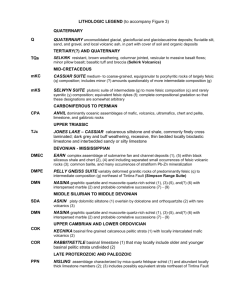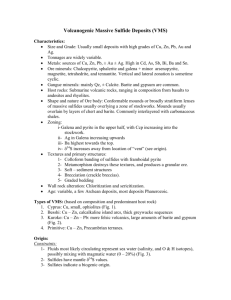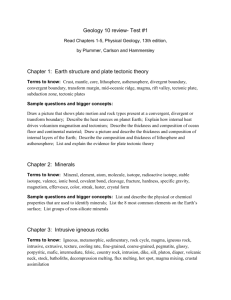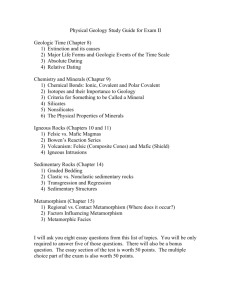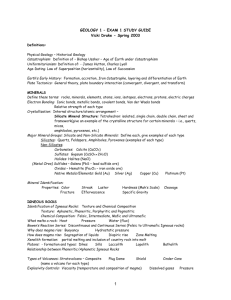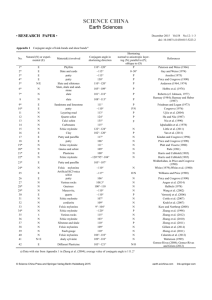Devils Track Lake
advertisement
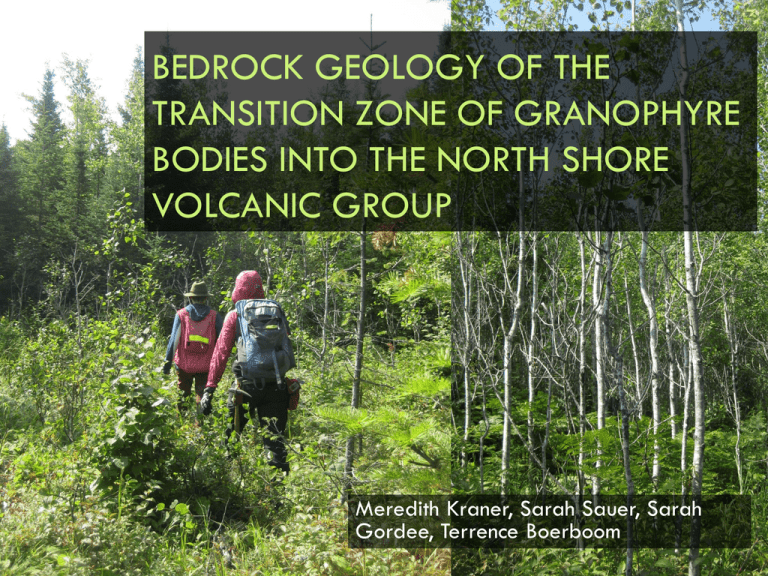
BEDROCK GEOLOGY OF THE TRANSITION ZONE OF GRANOPHYRE BODIES INTO THE NORTH SHORE VOLCANIC GROUP Meredith Kraner, Sarah Sauer, Sarah Gordee, Terrence Boerboom Sarah S. Terry TEAM TERRY Meredith Sarah G. OBJECTIVES Produce a detailed map of the southern margins of the Lima and Pine Mountain quadrangles, Cook County, Minnesota which was previously only mapped on a regional scale. Past work has shown that current reconnaissance geologic maps left out a great deal of detail. Delineate volcanic stratigraphy in areas currently defined as ‘North Shore Volcanic Group, undivided.’ Secondly, define the intrusive (and possibly faulted) relationships with the Brule-Hovland diabase/gabbro and Eagle Mountain granophyre bodies. The volcanic rocks have been metamorphosed by the intrusions, and the felsic volcanics have likely been remelted by the mafic intrusions, forming small marginal hybrid bodies. BASECAMP c MAPPING AREA Regional Geology Regional Geology • • • Volcanic rocks likely to include everything from rhyolite to basalt. They are also contact metamorphosed and expect to see hybrid border phases adjacent to mafic intrusions. Gabbroid to granophyric intrusions, intermediate border phases. Probably many smaller dikes/sills within volcanic pile. Area previously mapped by Davidson in 1977 Field Logistics Field area was accessed by vehicle or ATV. Wide range of field conditions varying from dense, impenetrable bush to swamps, fields and steep cliffs. Used LiDar to help locate feasible outcrop FIELD OPERATIONS c Rock Types Mafic to felsic volcanics • Rhyolite, Andesite, Basalt Intrusive • Granophyre, FerromonzoniteFerromonzodiorite, diabase Sedimentary • Sandstone Felsic to Intermediate Intrusive Rocks Leucogranite: Pink, micrographic to intergranular Felsic to Intermediate Intrusive Rocks Ferrogranite to ferromonzodiorite: fine- to medium-grained, locally coarse grained, weakly porphyritic, with white-bleached, feltytextured plagioclase surrounded by pink alkali feldspar and granophyre Locally contains sparse glassy quartz grains, and commonly contains finegrained granophyric quartz and alkali feldspar intergrowths. Felsic to Intermediate Intrusive Rocks Unit also includes oxide-rich, medium- to coarse-grained, equigranular to ophitic, augite troctolite to olivine gabbro These units exhibit complex internal contact relationships. Olivine gabbro Augite troctolite Felsic Volcanics Rhyolite: Plagioclase- and pyroxene-porphyritic Very fine-grained to aphanitic, locally conchoidally fracturing groundmass Incipient columnar jointing is observed locally Rhyolite Interpreted to be a lava, this unit locally appears to be a fine-grained marginal phase of ferrogranite to ferromonzodiorite units and also exhibits intrusive contacts with adjacent fine-grained basalt and andesite lava units. Intermediate Volcanics Andesite: Coherent fine-grained, feltyand intergranulartextured, with minor proportions of small, pink-altered, rectangular plagioclase phenocrysts Andesite Flow-top breccia monomictic, chaotic, clast-supported, angular, amygdaloidal andesite breccia very fine-grained, siliceous matrix that is interpreted to be silt or sandstone Mafic Volcanics Basalt: Felty-textured medium-grained, subophitic to subprismatic, and locally amygdaloidal. Contains sparse, small blocky, epidote-altered plagioclase phenocrysts, variably altered poikilitic to subprismatic augite, minor Fe-Ti oxides, chlorite and apatite. Amygdules are locally filled with epidote, chlorite and quartz. Basalt Ophitic Brown to mottled maroon and gray Fine- to mediumgrained Oikocrysts up to 7 millimeters Locally amygdaloidal Interflow sedimentary rocks Sandstone: fine-grained, well-sorted litharenite to litharkose thin beds are distinguished via variations in grain size. Contains abundant clear, glassy quartz grains in relatively more coarsegrained beds Miscellaneous diabase intrusions Ophitic Diabase fine- to medium-grained, inequigranular, ophitic constituent minerals include plagioclase, augite, olivine and Fe-Ti oxides relatively resistant and can be traced along strike as narrow, lowlying topographic ridges Structures & Textures Glacial Striations Ophitic Texture S t r u c t u r e s & T e x t u r e s RED ROCK CONFUSION GRANOPHYRE MONZONITE Geologic findings Mapped half a quadrangle in area Determined which units were ridge forming units and which were low forming units Observed 2 or 3 actual contacts in outcrop Mapped a total of 347 outcrops Contacts were also inferred based on the observed relative resistance of the units along with the lateral continuity along strike using LiDar. The presence of the fault is inferred based on the truncation of laterally continuous units along strike. Based on ongoing mapping, we were able to extend rock units from the adjacent Grand Marais quadrangle ACKNOWLEDGMENTS WITH THANKS TO TERRY BOERBOOM, DIRECTORS OF THE PRECAMBRIAN RESEARCH CENTER; JIM MILLER, DEAN PETERSON, GEORGE HUDAK. ADDITIONAL THANKS TO THE PRIVATE AND CORPORATE CONTRIBUTORS WHO MADE THIS PROJECT POSSIBLE References cited Miller, J.D., Jr., Green, J.C., Severson, M.J., Chandler, V.W., and Peterson, D.M., 2001, Geologic map of the Duluth Complex and related rocks, northeastern Minnesota: Minnesota Geological Survey Miscellaneous Map M-119, pl. 1, scale 1: 200,000. Boerboom, T.J., and Green, J.C., 2010, Bedrock Geology of the Grand Marais Quadrangle, Cook County, Minnesota: Minnesota Geological Survey Miscellaneous Map M-189, scale 1: 24,000. Vervoort, J.D., Wirth, K., and Kennedy, B., 2007, The magmatic evolution of the Midcontinent rift: New geochronologic and geochemical evidence from felsic magmatism: Precambrian Research, v. 157, nos. 1-4, p. 235-268. Davidson, D.M., Jr., 1977, Reconnaissance geologic map of the Pine Mountain quadrangle, Cook County, Minnesota: Minnesota Geological Survey Miscellaneous Map M-31, scale 1:24,000.
